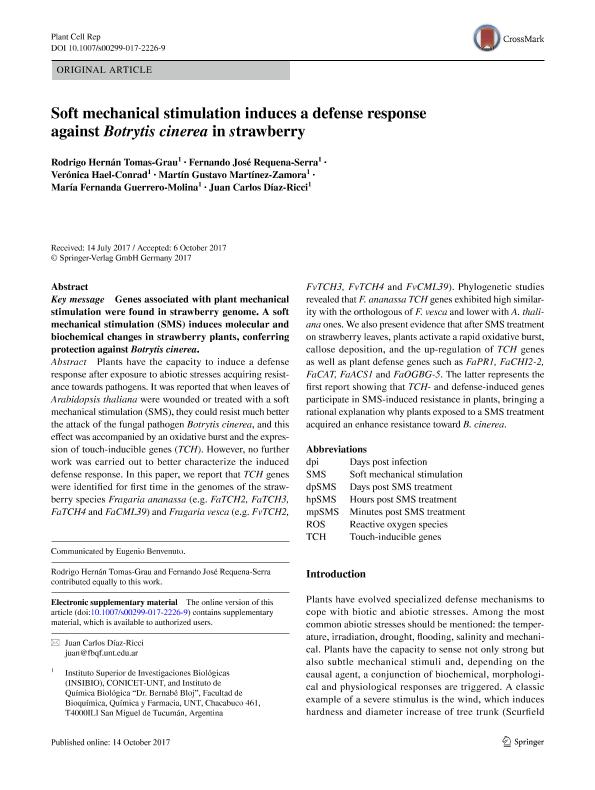Mostrar el registro sencillo del ítem
dc.contributor.author
Tomas Grau, Rodrigo Hernán

dc.contributor.author
Requena Serra, Fernando José

dc.contributor.author
Hael Conrad, Verónica

dc.contributor.author
Martinez Zamora, Martin Gustavo

dc.contributor.author
Guerrero Molina, María Fernanda

dc.contributor.author
Diaz Ricci, Juan Carlos

dc.date.available
2018-08-01T21:09:27Z
dc.date.issued
2018-02
dc.identifier.citation
Tomas Grau, Rodrigo Hernán; Requena Serra, Fernando José; Hael Conrad, Verónica; Martinez Zamora, Martin Gustavo; Guerrero Molina, María Fernanda; et al.; Soft mechanical stimulation induces a defense response against Botrytis cinerea in strawberry; Springer; Plant Cell Reports; 37; 2; 2-2018; 239-250
dc.identifier.issn
0721-7714
dc.identifier.uri
http://hdl.handle.net/11336/53848
dc.description.abstract
Key message: Genes associated with plant mechanical stimulation were found in strawberry genome. A soft mechanical stimulation (SMS) induces molecular and biochemical changes in strawberry plants, conferring protection againstBotrytis cinerea. Abstract: Plants have the capacity to induce a defense response after exposure to abiotic stresses acquiring resistance towards pathogens. It was reported that when leaves of Arabidopsis thaliana were wounded or treated with a soft mechanical stimulation (SMS), they could resist much better the attack of the fungal pathogen Botrytis cinerea, and this effect was accompanied by an oxidative burst and the expression of touch-inducible genes (TCH). However, no further work was carried out to better characterize the induced defense response. In this paper, we report that TCH genes were identified for first time in the genomes of the strawberry species Fragaria ananassa (e.g. FaTCH2, FaTCH3, FaTCH4 and FaCML39) and Fragaria vesca (e.g. FvTCH2, FvTCH3, FvTCH4 and FvCML39). Phylogenetic studies revealed that F. ananassa TCH genes exhibited high similarity with the orthologous of F. vesca and lower with A. thaliana ones. We also present evidence that after SMS treatment on strawberry leaves, plants activate a rapid oxidative burst, callose deposition, and the up-regulation of TCH genes as well as plant defense genes such as FaPR1, FaCHI2-2, FaCAT, FaACS1 and FaOGBG-5. The latter represents the first report showing that TCH- and defense-induced genes participate in SMS-induced resistance in plants, bringing a rational explanation why plants exposed to a SMS treatment acquired an enhance resistance toward B. cinerea.
dc.format
application/pdf
dc.language.iso
eng
dc.publisher
Springer

dc.rights
info:eu-repo/semantics/openAccess
dc.rights.uri
https://creativecommons.org/licenses/by-nc-sa/2.5/ar/
dc.subject
Soft Mechanical Stimulation (Sms)
dc.subject
Fragaria X Ananassa
dc.subject
Botrytis Cinerea
dc.subject
Mechanical-Induced Defense Response
dc.subject.classification
Otras Ciencias Biológicas

dc.subject.classification
Ciencias Biológicas

dc.subject.classification
CIENCIAS NATURALES Y EXACTAS

dc.subject.classification
Otras Biotecnología Agropecuaria

dc.subject.classification
Biotecnología Agropecuaria

dc.subject.classification
CIENCIAS AGRÍCOLAS

dc.title
Soft mechanical stimulation induces a defense response against Botrytis cinerea in strawberry
dc.type
info:eu-repo/semantics/article
dc.type
info:ar-repo/semantics/artículo
dc.type
info:eu-repo/semantics/publishedVersion
dc.date.updated
2018-07-30T13:48:59Z
dc.journal.volume
37
dc.journal.number
2
dc.journal.pagination
239-250
dc.journal.pais
Alemania

dc.journal.ciudad
Berlín
dc.description.fil
Fil: Tomas Grau, Rodrigo Hernán. Consejo Nacional de Investigaciones Científicas y Técnicas. Centro Científico Tecnológico Conicet - Tucumán. Instituto Superior de Investigaciones Biológicas. Universidad Nacional de Tucumán. Instituto Superior de Investigaciones Biológicas; Argentina
dc.description.fil
Fil: Requena Serra, Fernando José. Consejo Nacional de Investigaciones Científicas y Técnicas. Centro Científico Tecnológico Conicet - Tucumán. Instituto Superior de Investigaciones Biológicas. Universidad Nacional de Tucumán. Instituto Superior de Investigaciones Biológicas; Argentina
dc.description.fil
Fil: Hael Conrad, Verónica. Consejo Nacional de Investigaciones Científicas y Técnicas. Centro Científico Tecnológico Conicet - Tucumán. Instituto Superior de Investigaciones Biológicas. Universidad Nacional de Tucumán. Instituto Superior de Investigaciones Biológicas; Argentina
dc.description.fil
Fil: Martinez Zamora, Martin Gustavo. Consejo Nacional de Investigaciones Científicas y Técnicas. Centro Científico Tecnológico Conicet - Tucumán. Instituto Superior de Investigaciones Biológicas. Universidad Nacional de Tucumán. Instituto Superior de Investigaciones Biológicas; Argentina
dc.description.fil
Fil: Guerrero Molina, María Fernanda. Consejo Nacional de Investigaciones Científicas y Técnicas. Centro Científico Tecnológico Conicet - Tucumán. Instituto Superior de Investigaciones Biológicas. Universidad Nacional de Tucumán. Instituto Superior de Investigaciones Biológicas; Argentina
dc.description.fil
Fil: Diaz Ricci, Juan Carlos. Consejo Nacional de Investigaciones Científicas y Técnicas. Centro Científico Tecnológico Conicet - Tucumán. Instituto Superior de Investigaciones Biológicas. Universidad Nacional de Tucumán. Instituto Superior de Investigaciones Biológicas; Argentina
dc.journal.title
Plant Cell Reports

dc.relation.alternativeid
info:eu-repo/semantics/altIdentifier/url/http://link.springer.com/10.1007/s00299-017-2226-9
dc.relation.alternativeid
info:eu-repo/semantics/altIdentifier/doi/https://dx.doi.org/10.1007/s00299-017-2226-9
Archivos asociados
